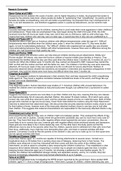Research Summaries
Baron-Cohen et al (1985)
Researched the link between the cause of autism, and its higher frequency in males, he proposed that autism is
caused by the extreme male brain, where people are better at “systemising” than “empathising”. He points out that
females are better at empathising, and men are better at systemising. He proposed there may a biological link to
this, to do with testosterone, and therefore suggested autism is caused by testosterone, and an extreme male
brain.
Belsky (1986)
Sounded warnings about day care for children, warning that it could make them more aggressive in later childhood
and adolescence. These risks are emphasised if day care began during the child’s first year of life, the child
received more than 20 hours per week of day care, and if day care is continuous, right up until school age. This
means that many children who start day care at a later age, or spend less time in day care are unaffected by it.
Belsky and Pluess (2011)
Studied the effect of day care on American children with different temperaments under the age of 5. “Difficult”
temperaments were identified when the children were under 5, when the children were 15, they were studied
again, to look for externalising behaviour. The “difficult” children who experienced low quality day care showed
more externalising behaviour than children with other temperaments, however there was no difference among the
children who had experienced high quality day care.
Belsky and Rovine (1988)
Found that patient and sensitive carers can help insecure children develop secure attachments. Belsky and
Rovine studied 149 infants, who were the first born children of married middle class families in America. They
interviewed the families about the day care they used when the children were 3 months old, 9 months old, and 12
months old. When the children were 12 months old, they carried out Ainsworth’s SSP, however they carried the
SSP out first with the mother and then with the father too, later. The children in full time day care were insecurely
attached, 20 hours per week of day care seemed to be the cut off point for secure attachment. Mothers of
insecurely attached infants showed less sensitivity and empathy in interviews and expressed unhappiness in their
marriages, they said the infants were more fussy and difficult when they were 3 months old.
Chapman et al (2006)
Tested 100 pregnant mothers for testosterone in their amniotic fluid, and later measured the child’s empathising
skills aged 6-8. They found a negative correlation between testosterone levels in the womb, and things like eye
contact and social relationships.
Kanner (1943)
First diagnosed autism. Kanner described case studies of 11 American children with unusual behaviours. He
realised the children were not retarded as had previously been thought, but suffered from a syndrome he called
autism.
Koren-Karie (2001)
Suggests that insecure parents are more likely to put their children into day care, meaning that day care classes
are disproportionately full of insecurely attached children. She tested 76 Israeli mothers, 38 of which were using
nursery day care while they returned to work, and the remainder stayed at home on maternity leave. Both of these
groups were matched on age and social class. Koren-Karie interviewed the mothers using the Adult-Attachment
Interview to determine their attachment type. She discovered that securely attached mothers mostly chose to care
for their babies at home, however more of the insecurely attached mothers chose to use day care to look after
their children. This suggests that maternal characteristics are responsible for the insecurely attached infants in day
care.
Kottelenberg and Lehrer (2017)
Discovered that the effects of day care on children might vary between gender. They analysed the effects of day
care on 5 year olds in Quebec, Canada where the government subsidises day care so much that it only costs $7
per day. They found that boys who suffer negative effects show hyperactivity and poor concentration, they are
more likely to be in nursery day care, however girls with negative effects show emotional anxiety and depression,
these girls are more likely to be in home based day care. On the other hand, this study points out that the
differences may be due to the parents rather than the children, parents tend to withdraw form their girls more than
their boys, additionally, boys might be more demanding than girls, and insist on special activities with their
parents. Conversely it could be that the parents of the children in day care try to make up for it in their spare time
and do special activities with them.
Schaffer and Emerson (1964)
Found that children aged 12+ months are capable of forming attachments to several carers. Carried out a
longitudinal study on 60 babies from a working class area of Glasgow, observing them in their homes. The
children were observed in how they interacted with their carers and then the carers of the children were
interviewed, as well as asked to complete a diary measuring the children’s behaviour. They established a clear
sequence which babies followed, responding in a similar way to people and objects aged less than 3 months,
enjoying human interaction aged up to 6 months, but showing a preference for more familiar people. By 12
months, the children had established stranger anxiety and separation anxiety, and by 12+ months, they had
become increasingly independent and only formed attachments to up to 5 people.
Sylva et al (2003)
Conducted longitudinal study investigating the EPPE project, launched by the government. Sylva studied 3000
children, aged 3-11, from a range of backgrounds. There were 2 groups of children, children attending day care,




